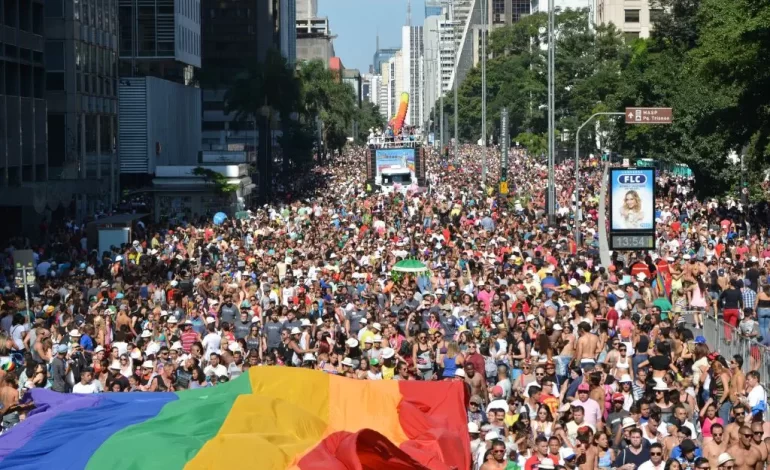10 LGBTQ+ Events In Latin America You Must See
Experience the most thrilling yearly LGBTQ+ events in Latin America, ranging from queer tango competitions and wine festivals to inspirational Pride marches and big-name carnivals. Latin America is a growing destination for the same travellers, with an exciting array of queer events on its social calendar. There is rarely a terrible time to visit, whether you are arranging your vacation around Pride Month celebrations or seeking some cultural enrichment with special-interest festivals. 1. Gay Pride in São Paulo- June Every year, São Paulo hosts the largest LGBT pride event in the world, which draws millions of spectators. its typically business-oriented city just once matches Rio de Janeiro on the celebration circuit with its full-force spectacular. Famous skyscrapers, art nouveau homes, museums, and other cultural institutions flank the city’s main thoroughfare, Avenida Paulista, which serves as the parade’s main route. Usually held in June, the Feira Cultural Da Diversidade LGBT+ coincides with a full week of events that include art exhibits, drag competitions, dining out, and other highlights. 2. Carnival in Rio de Janeiro: February / March Nothing compares to the Carnival in Rio de Janeiro. Depending on the Easter calendar, millions of people attend the event in February or March. The most celebratory days are Ash Wednesday and Lent, which fall on Monday and Tuesday before the Christian celebration. The Sambadrome, a linear stadium created by Brazilian architect Oscar Niemeyer, is the focal point of the celebration, and certain travel packages allow guests to march while dressed in costume. Most venues are LGBT-friendly, but two must-see events are the gay beach block party in Ipanema, Rua Farme de Amoedo, and the LGBT Ball at the Scala Club. 3. Buenos Aires Queer Tango Festival: Dates may vary In 2009, the tango—a blend of indigenous, European, African, and New World dance forms—was included to UNESCO’s Representative List of the Intangible Cultural Heritage of Humanity. Its origins can be found in Argentina’s history of same-sex relationships, when men would frequently dance together for the sole purpose of impressing onlookers. Following the peso crisis of the early 2000s, which caused severe financial instability throughout the nation, LGBTQ+ tango salons started to appear. Guests can observe this traditional Buenos Aires art form through a gay lens or participate by sitting back. 4. All-Vendimia or Vendimia para Todxs: February / March The Vendimia is already a unique and colourful wine festival, with juice-stained, ballgown-wearing beauty queens representing Argentina’s wine regions atop parade floats tossing grapes, melons, bottles of wine, and other agricultural items into the crowds lining Mendoza’s streets. With a beauty queen competition featuring homosexual, transgender, and drag candidates in addition to other entertainment, The homosexual Vendimia, also known as Vendimia for All, greatly heightens the wild enjoyment. The event takes place in February or March, coinciding with the nation’s yearly grape harvest, and is unquestionably the largest, if not the only, queer wine festival in the world. 5. The Pride Parade and Pride Festival in Vallarta: May Although Puerto Vallarta is a gay-friendly vacation spot all year long, the Vallarta Pride Parade and Festival in late May bring this energetic city with a view of the Pacific to life. The Saturday Parade, which takes place along Malecón’s waterfront and draws thousands of spectators to honour the community, is the main event. Throughout the week-long event, there will be art exhibits, unique culinary experiences, bar parties, and more highlights. It is a popular time to visit this city, which used to be the exclusive retreat of Hollywood stars like Elizabeth Taylor, albeit increasingly crowded. 6. Amor Film Festival: June / July The Amor International LGBT+ Film Festival, established in 2016, takes place in Santiago, Chile from late June to early July, and is a great option for those looking for a sedate and thought-provoking event. Despite being an international festival, queer Latin American and Iberian submissions in Spanish and Portuguese are given special attention. Discover the Chilean capital while watching new films and having cinematic discussions at the various screening and event venues, which include the Teatro Municipal de Maipu, the Comunidad Cultural Comunitaria La Inclusiva, and the Cineteca Nacional. 7. Cuba’s Gay Pride March and Festival in Havana: May Travelling to Cuba has always been welcoming to LGBT people. Through Mariela Castro, the daughter of former leader Raul Castro, and her organisation, Cenesex, the communist nation has also been an interesting player in the worldwide LGBTQ+ rights movement, with a particular focus on transgender issues. It is imperative for its+ activists to follow party lines, and this vibrant late-May festival in Havana’s famed streets is typically an official government-sponsored event that typically promotes a predetermined narrative. This is a unique and fascinating moment to observe Cuban politics in action, as peaceful protests are occasionally possible. 8. Barranquilla’s Carnaval Gay: Easter Week Barranquilla receives fewer visits from LGBTQ+ event tourists, but it is most well-known for its thrilling carnival. Located on the Caribbean coast of Colombia, the city is host to the Barranquilla Carnaval, one of the biggest celebrations in South America. Alongside the main parades, there are many of its activities; thus, it is unlikely that this complex spectacle will stay a secret for very long. Like many other carnivals, its schedule is dependent on Easter dates. Marches, cultural excursions, parties, drag pageants, and other feather-adorned spectacles with loud music are all part of the colourful week of activities. 9. Gay Pride in San Juan: June Despite the challenging times Puerto Rico has faced recently—including natural catastrophes and economic downturns—San Juan Pride endures. One of the biggest events of the Caribbean takes place in early June, when locals and tourists alike fill the bars, eateries, and nightclubs along Avenida Condado, this sector of the Condado neighbourhood. With a lineup of participants, floats, music, and dancers, the parade begins early from its staging grounds in Parque del Indio in front of the beach. It then proceeds up Ashford Avenue. At Parque del Tercer Milenio, there will be a rally, a show with activists, singers, drag performers, and other acts.
Read More

